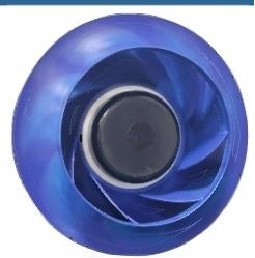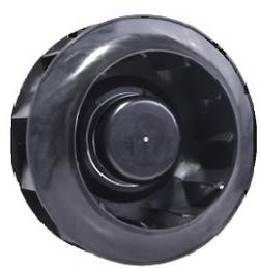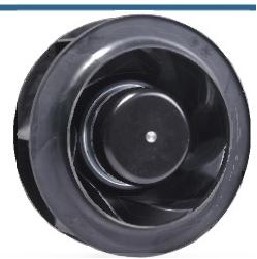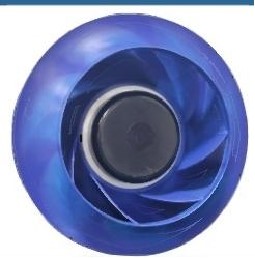What Makes EC Fans More Efficient? A Complete Guide to Next-Generation Electronically Commutated Fan Technology

Key Takeaways
-
EC fans integrate brushless DC efficiency with AC convenience
-
Intelligent electronic commutation eliminates mechanical friction
-
15–30% lower energy consumption vs. traditional AC fans
-
Supports 0–10 V / PWM / RS485 / Modbus variable-speed control
-
Superior power factor, low noise, and long service life
-
Ideal for HVAC, cleanrooms, data centers, industrial cooling, and smart buildings
1. What Is an EC Fan?
An EC (Electronically Commutated) fan is a brushless DC motor fan driven by a built-in electronic controller.
It combines:
-
DC motor efficiency
-
AC power input compatibility
-
Intelligent control and variable-speed operation
EC fans can be made as axial fans or centrifugal fans, offering a versatile technology platform suitable for HVAC, ventilation, cooling, and filtration systems.
2. Types of EC Fans
2.1 EC Axial Fans
EC axial fans move air parallel to the rotation axis, offering:
-
High airflow volume
-
Lower noise
-
Compact structure
They are ideal when airflow demand is high but system pressure is low, such as:
-
Building ventilation
-
Electronic cooling
-
Fresh air systems
-
Light HVAC applications
2.2 EC Centrifugal Fans
EC centrifugal fans move air axially at the inlet and radially at the outlet.
They provide:
-
Higher static pressure
-
Stronger system resistance handling
-
Stable airflow across varying loads
Common applications include:
-
AHUs
-
FFUs
-
Data center CRAC/CRAH units
-
Industrial filtration
-
Heating and cooling systems
3. How EC Fans Work: The Technology Inside
EC fans operate using:
-
Permanent magnet synchronous motor (PMSM)
-
Built-in electronic commutator replacing mechanical commutation
3 Working Stages
1) AC to DC Conversion
The internal controller converts AC mains into DC power.
2) Magnetic Field Control
The controller detects rotor position and generates a synchronized rotating magnetic field.
→ No brushes, no mechanical friction.
3) Intelligent Speed & Airflow Control
Supports multiple signal inputs:
-
0–10 V
-
PWM
-
RS485
-
4–20 mA
-
Modbus
This enables:
-
Precise airflow
-
Pressure stability
-
Real-time load adjustment
EC fans eliminate traditional induction motor losses:
-
No slip
-
No rotor copper loss
-
No excitation loss
Result: Higher efficiency + better power factor + smooth variable speed.
4. EC Fan vs. Traditional AC Fan (Comparison)
| Feature | EC Fan | AC Fan |
|---|---|---|
| Efficiency | ★★★★★ (85–92%) | ★★☆☆☆ (55–70%) |
| Speed Control | Continuous, smooth | Limited, inefficient |
| Power Factor | High | Low–medium |
| Noise | Lower | Higher |
| Heat Generation | Minimal | Significant |
| Lifespan | Long | Medium |
| Energy Savings | 15–30% | — |
| Maintenance | Very low | Higher |
→ EC fans outperform AC fans in every dimension that affects lifecycle cost.
5. Where EC Fans Are Used
EC fans are now essential across modern industries because they offer precise control, stable airflow, and significant energy reduction.
5.1 Commercial & Residential Applications
-
Central HVAC systems
-
Fresh-air ventilation systems
-
Air purifiers
-
Smart building environmental control
They can automatically adjust airflow based on:
-
Temperature
-
Humidity
-
CO₂ concentration
-
Occupancy
This improves comfort while reducing electricity consumption.
5.2 Industrial Applications
-
Factory ventilation
-
Process exhaust
-
Equipment cooling
-
Dust collection systems
-
Generator and inverter cooling
-
Pharmaceutical & chemical filtration
EC fans provide stable pressure and consistent airflow, ensuring:
-
Reliable cooling
-
Stable filtering
-
Precise environmental control
In high-sensitivity industries (pharma, electronics), EC fans help maintain cleanroom stability.
Conclusion
EC fans represent the future of ventilation, HVAC, and industrial cooling.
With high efficiency, intelligent control, low noise, long life, and low maintenance, EC technology offers both technical and economic advantages.
Choosing an EC fan is no longer just a product choice—
it is a strategic move toward low carbon, high efficiency, and intelligent system design.
FAQ — EC Fan Technology
Why are EC fans more energy-efficient?
They eliminate mechanical commutation loss and run with a permanent magnet synchronous motor.
Can EC fans replace traditional AC fans?
Yes. Many EC models are designed as drop-in replacements.
Do EC fans support variable speed?
Yes—0–10 V, PWM, RS485, and Modbus.
Are they suitable for industrial use?
Absolutely. They are widely used in AHUs, CRACs, cleanrooms, and industrial cooling.
-
Request an EC Fan Technical Guide →
-
Ask for an EC Fan Energy-Saving Comparison →
-
Get an OEM Consultation for EC Retrofit →
-
Dual-Inlet EC Centrifugal Fan — High-Volume, Low-Noise, Smart-Control Airflow for Next-Generation Systems
2025-11-14
-
Backward Centrifugal Fan Innovation for Ventilation Systems Efficiency
2025-11-14
-
PC Cooling Innovation: The DC Brushless PWM FG 8015 Fan Advantage
2025-10-31
-
Longer Service Life: Why DC Axial Fans Win in HVAC Innovation
2025-11-07
-
Customer Success Story — High-Efficiency Fan for FFU Cleanroom Applications
2025-10-24
-
The New EU ErP Directive — Redefining Energy Efficiency and Fan Technology for the Future
2025-10-24
-
High-End Equipment Cooling Solutions — AFL Fans Powering the Future of Precision Manufacturing
2025-10-24
-
High-Efficiency EC Fan Solutions for Data Centers — Precision Cooling, Reliability, and Energy Optimization
2025-10-24
-
Custom EC & AC External Rotor Fans for HVAC OEMs — Precision Engineering, 15-Day Delivery, and R&D Validation
2025-10-24
-

AFL External Rotor Fans Axial Fans in Fan Solutions for the Renewable Energy Industry
-

DC Backward Centrifugal Fans - AFL Fans Premium Solution for Industrial Ventilation
-

DC Backward Centrifugal Fans φ250 – High-Performance Industrial Fans
-

High-Quality DC Backward Curved Centrifugal Fans φ220 for Industrial Applications | Trusted Supplier in China
-

DC Backward Centrifugal Fans φ225 for Industrial and Commercial Use


